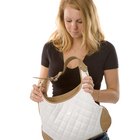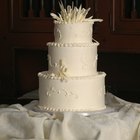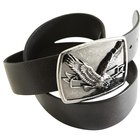
Cake frosting is quite sticky, and it hardens as it dries -- two qualities that make it an effective and edible glue for reassembling broken cakes. Baked cakes can break if the bottom sticks to the pan, or if they aren't completely cool before you attempt to remove them. When a cake comes out of the oven, the center is still soft, requiring a cooling period to set the center. Other times, a corner might break off the cake inadvertently, even if the cake is properly cooled and it comes out of the pan cleanly.
Step 1
Let the broken cake finish cooling completely before you touch any of the pieces. If a corner breaks off the cake and falls on the counter, leave it there; handling it while it's warm can cause it to crumble into several smaller pieces that are more difficult to piece together.
Step 2
Insert a round decorating tip in a decorating bag and fill the bag with butter-cream frosting. Choose a frosting color that closely matches the cake color, if possible, to make the patch difficult to detect.
Step 3
Squeeze the frosting generously onto the exposed cake on both the broken piece and the main part of the cake. Spread it evenly with a decorating spatula. If the icing is difficult to spread, dip the spatula in a drinking glass filled with hot water. The water heats the blade so it warms and melts the icing partially as you spread.
Step 4
Line up the broken piece with the broken area on the main cake, fitting the shapes together just as you would assemble a puzzle. Push the broken piece onto the cake and hold it for a few seconds until it sticks. If you have a number of broken pieces, apply the pieces one at a time.
Step 5
Squeeze a line of frosting over all the seams where the broken pieces connect. Spread the frosting with a spatula so it's smooth and even. If any gaps remain in the patch job, fill it in with extra frosting. For example, if a small piece crumbled so much that you can't put it back on the cake, fill it in with frosting. Wait about 20 minutes for the frosting to harden.
Step 6
Lay a non-textured paper towel over the frosted seams. Rub your hand gently over the back of the paper towel to smooth out the frosting.
Step 7
Spread a thin layer of frosting over the entire cake to seal in any crumbs, even with the frosting on the seams. Decorate the cake as desired after applying the crumb coat.
Related Articles

How to Glue a Leather Shoe Strap

Can You Frost a Cracked Cheesecake?

How to Defrost a Frozen Cake With ...

How to Repair Foam Rubber Shoes
Freezing a Cake With Buttercream ...

How to Repair Leather Handbag Handles

How to Decorate Fake Cakes

How to Repair a Split Rubber Sole

How to Make Whipped Cream Filled ...

How to Fix a Nike Cortez If the Sole Is ...

How to Make Buttercream Frosting Spread ...

How to Repair a Torn Lambskin Leather ...

How to Make Petit Fours

How to Lengthen Dress Coat Sleeves

How to Repair a Leather Belt

How to Repair a Fiberglass Swimming Pool

How to Make a Number Six Cake

Half Sheet Cake Cooling Instructions

How to Patch a Waterproof Rain Jacket

How to Make a Motorcycle Birthday Cake
References
Tips
- If a piece of cake won't stay in place, try inserting toothpicks as anchors until the icing hardens. Leave them in place if the frosting won't hold the cake in place even after it hardens, but warn guests to be wary of the toothpicks.
Writer Bio
A former cake decorator and competitive horticulturist, Amelia Allonsy is most at home in the kitchen or with her hands in the dirt. She received her Bachelor's degree from West Virginia University. Her work has been published in the San Francisco Chronicle and on other websites.
Photo Credits
Thinkstock/Comstock/Getty Images